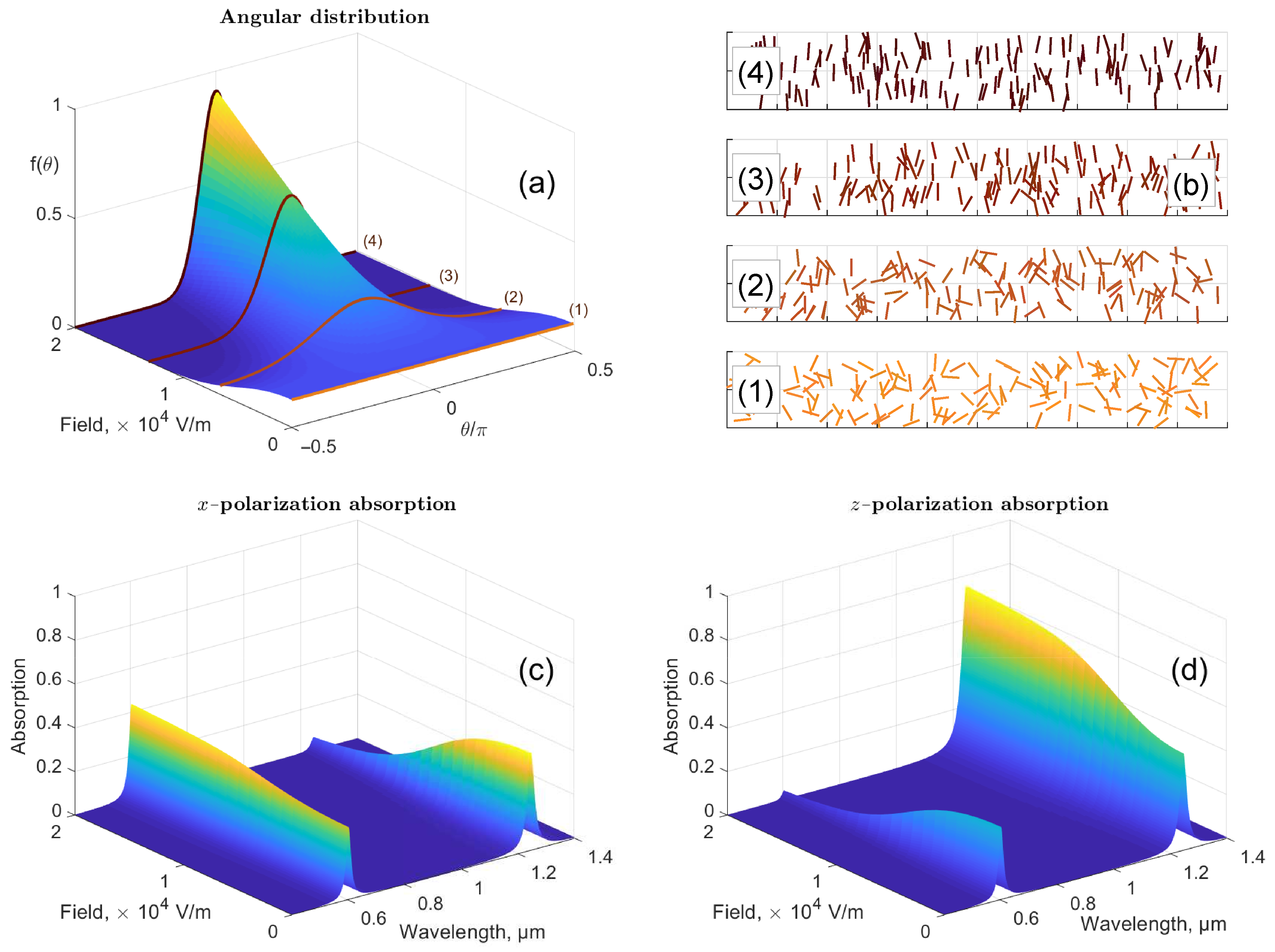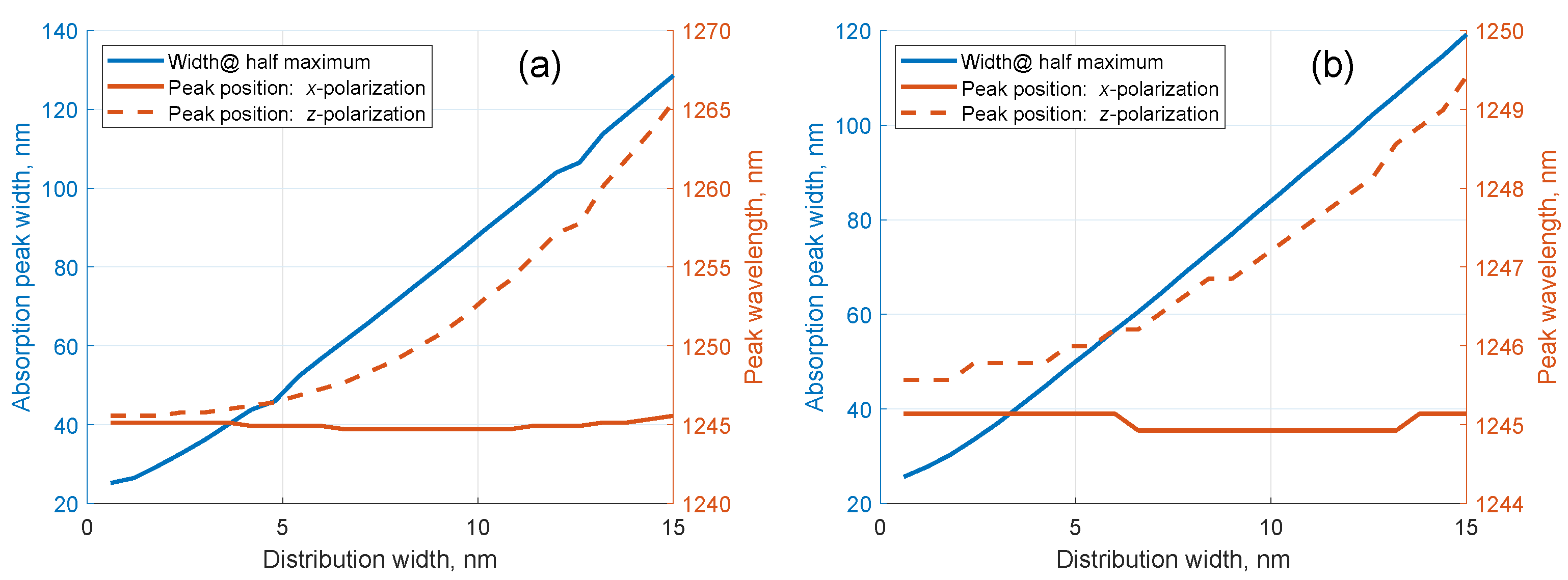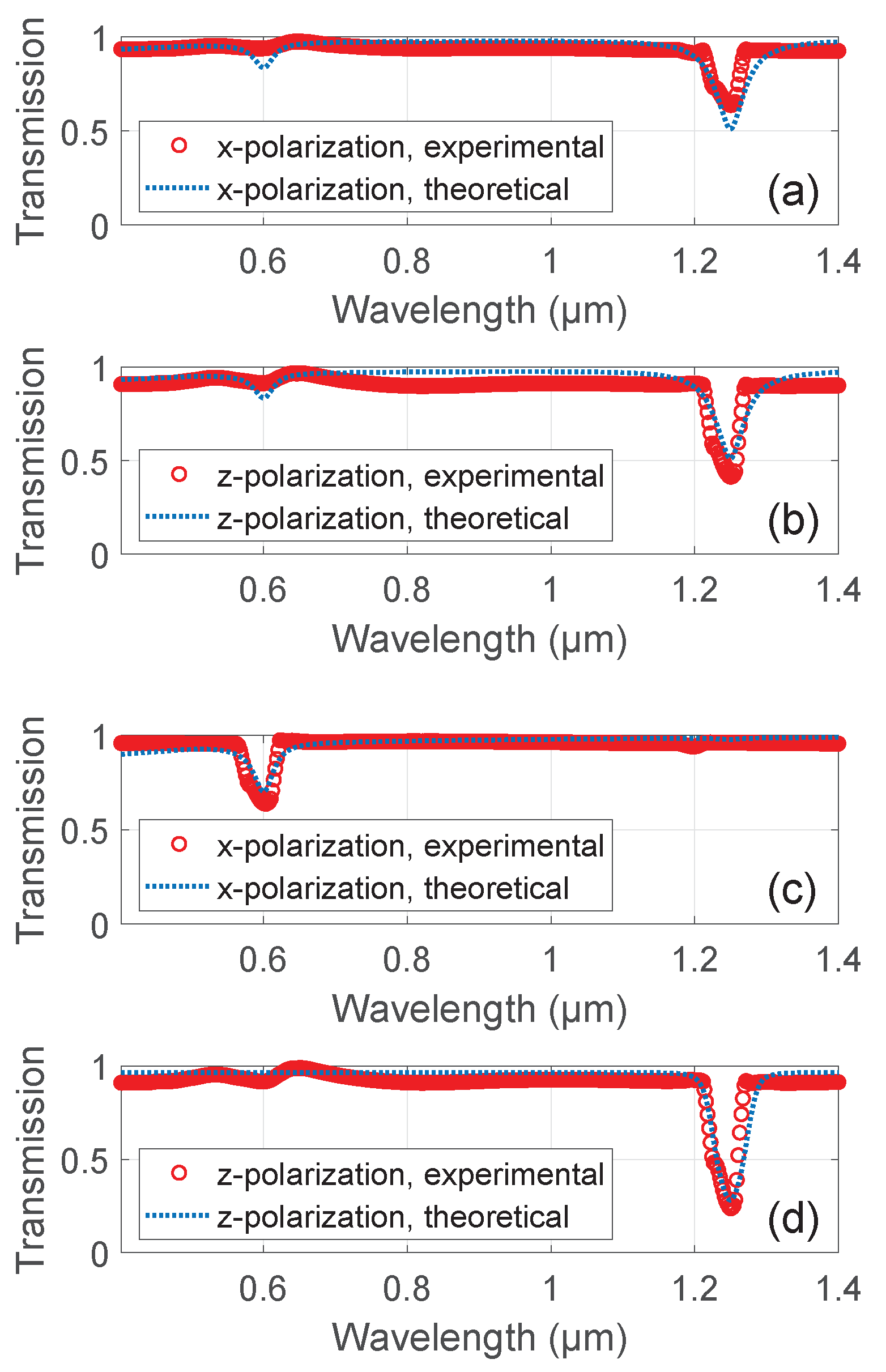Control of Light Transmission in a Plasmonic Liquid Metacrystal
Abstract
1. Introduction
2. Theory
3. Experiment
4. Results and Discussion
5. Conclusions
Author Contributions
Funding
Data Availability Statement
Conflicts of Interest
References
- Smith, D.R.; Padilla, W.J.; Vier, D.C.; Nemat-Nasser, S.C.; Schultz, S. Composite medium with simultaneously negative permeability and permittivity. Phys. Rev. Lett. 2000, 84, 4184. [Google Scholar] [CrossRef] [PubMed]
- Shelby, R.A.; Smith, D.R.; Schultz, S. Experimental verification of a negative index of refraction. Science 2001, 292, 77. [Google Scholar] [CrossRef] [PubMed]
- Zhang, S.; Fan, W.; Minhas, B.K.; Frauenglass, A.; Malloy, K.J.; Brueck, S.R.J. Midinfrared resonant magnetic nanostructures exhibiting a negative permeability. Phys. Rev. Lett. 2005, 94, 037402. [Google Scholar] [CrossRef] [PubMed]
- Dolling, G.; Wegener, M.; Soukoulis, C.M.; Linden, S. Negative-index metamaterial at 780 nm wavelength. Opt. Lett. 2007, 32, 53. [Google Scholar] [CrossRef] [PubMed]
- Lezec, H.J.; Dionne, J.A.; Atwater, H.A. Negative refraction at visible frequencies. Science 2007, 316, 430. [Google Scholar] [CrossRef] [PubMed]
- Minovich, A.; Farnell, J.; Neshev, D.N.; McKervacher, I.; Karouta, F.; Tian, J.; Powell, D.A.; Shadrivov, I.V.; Tan, H.H.; Jagadish, C.; et al. Liquid crystal based nonlinear fishnet metamaterials. Appl. Phys. Lett. 2012, 100, 121113. [Google Scholar] [CrossRef]
- Zharov, A.A.; Shadrivov, I.V.; Kivshar, Y.S. Nonlinear properties of left-handed metamaterials. Phys. Rev. Lett. 2003, 91, 037401. [Google Scholar] [CrossRef]
- Noginov, M.A.; Barnakov, Y.A.; Zhu, G.; Tumkur, T.; Li, H.; Narimanov, E.E. Bulk photonic metamaterial with hyperbolic dispersion. Appl. Phys. Lett. 2009, 94, 151105. [Google Scholar] [CrossRef]
- Guo, Y.; Newman, W.; Cortes, C.L.; Jacob, Z. Applications of hyperbolic metamaterial substrates. Adv. Opt. Electron. 2012, 2012, 452502. [Google Scholar] [CrossRef]
- Poddubny, A.; Iorsh, I.V.; Belov, P.A.; Kivshar, Y.S. Hyperbolic metamaterials. Nat. Photonics 2013, 7, 948. [Google Scholar]
- Alù, A.; Silveirinha, M.; Salandrino, A.; Engheta, N. Epsilon-near-zero metamaterials and electromagnetic sources: Tailoring the radiation phase pattern. Phys. Rev. B 2007, 75, 155410. [Google Scholar] [CrossRef]
- Liu, R.; Cheng, Q.; Hand, T.; Mock, J.J.; Cui, T.J.; Cummer, S.A.; Smith, D.R. Experimental demonstration of electromagnetic tunneling through an epsilon-near-zero metamaterial at microwave frequencies. Phys. Rev. Lett. 2008, 100, 023903. [Google Scholar] [CrossRef]
- Zhang, W.; Song, Q.; Zhu, W.; Shen, Z.; Chong, P.; Tsai, D.P.; Qiu, C.; Liu, A.Q. Metafluidic metamaterial: A review. Adv. Phys. X 2018, 3, 1417055. [Google Scholar] [CrossRef]
- Schurig, D.; Mock, J.J.; Justice, B.J.; Cummer, S.A.; Pendry, J.B.; Starr, A.F.; Smith, D.R. Metamaterial electromagnetic cloak at microwave frequencies. Science 2006, 314, 977. [Google Scholar] [CrossRef]
- Edwards, B.; Alù, A.; Silveirinha, M.G.; Engheta, N. Experimental verification of plasmonic cloaking at microwave frequencies with metamaterials. Phys. Rev. Lett. 2009, 103, 153901. [Google Scholar] [CrossRef]
- Pendry, J.B. Negative Refraction Makes a Perfect Lens. Phys. Rev. Lett. 2000, 85, 3966. [Google Scholar] [CrossRef]
- Belov, P.A.; Hao, Y.; Sudhakaran, S. Subwavelength microwave imaging using an array of parallel conducting wires as a lens. Phys. Rev. B 2006, 73, 033108. [Google Scholar] [CrossRef]
- Pendry, J.B.; Schurig, D.; Smith, D.R. Controlling Electromagnetic Fields. Science 2006, 312, 1780. [Google Scholar] [CrossRef]
- Leonhardt, U. Optical Conformal Mapping. Science 2006, 312, 1777. [Google Scholar] [CrossRef]
- Tang, Y.; Cohen, A.E. Optical Chirality and Its Interaction with Matter. Phys. Rev. Lett. 2010, 104, 163901. [Google Scholar] [CrossRef] [PubMed]
- Plum, E.; Fedotov, V.A.; Zheludev, N.I. Optical activity in extrinsically chiral metamaterial. Appl. Phys. Lett. 2008, 93, 191911. [Google Scholar] [CrossRef]
- Zhang, F.; Pu, M.; Li, X.; Gao, P.; Ma, X.; Luo, J.; Yu, H.; Luo, X. All-Dielectric Metasurfaces for Simultaneous Giant Circular Asymmetric Transmission and Wavefront Shaping Based on Asymmetric Photonic Spin–Orbit Interactions. Adv. Func. Mater. 2017, 27, 1704295. [Google Scholar] [CrossRef]
- Yue, F.; Wen, D.; Xin, J.; Gerardot, B.D.; Li, J.; Chen, X. Vector Vortex Beam Generation with a Single Plasmonic Metasurface. ACS Photonics 2016, 3, 2022. [Google Scholar] [CrossRef]
- Devlin, R.C.; Ambrosio, A.; Rubin, N.A.; Balthasar Mueller, J.P.; Capasso, F. Arbitrary spin-to–orbital angular momentum conversion of light. Science 2017, 358, 896. [Google Scholar] [CrossRef] [PubMed]
- Urzhumov, Y.A.; Shvets, G.; Fan, J.A.; Capasso, F.; Brandl, D.; Nordlander, P. Plasmonic nanoclusters: A path towards negative-index metafluids. Opt. Express 2007, 15, 14129. [Google Scholar] [CrossRef] [PubMed]
- Fruhnert, M.; Muhlig, S.; Lederer, F.; Rockstuhl, C. Towards negative index self-assembled metamaterials. Phys. Rev. B 2014, 89, 075408. [Google Scholar] [CrossRef]
- Golovin, A.B.; Lavrentovich, O.D. Electrically reconfigurable optical metamaterial based on colloidal dispersion of metal nano-rods in dielectric fluid. Appl. Phys. Lett. 2009, 95, 254104. [Google Scholar] [CrossRef]
- Liz-Marzán, L.M. Tailoring Surface Plasmons through the Morphology and Assembly of Metal Nanoparticles. Langmuir 2006, 22, 32. [Google Scholar] [CrossRef]
- Fontana, J.; da Costa, G.K.B.; Pereira, J.M.; Naciri, J.; Ratna, B.R.; Palffy-Muhoray, P.; Carvalho, I.C.S. Electric field induced orientational order of gold nanorods in dilute organic suspensions. Appl. Phys. Lett. 2016, 108, 081904. [Google Scholar] [CrossRef]
- Liu, Q.; Cui, Y.; Gardner, D.; Li, X.; He, S.; Smalyukh, I.I. Self-Alignment of Plasmonic Gold Nanorods in Reconfigurable Anisotropic Fluids for Tunable Bulk Metamaterial Applications. Nano Lett. 2010, 10, 1347. [Google Scholar] [CrossRef]
- Šutka, A.; Timusk, M.; Loot, A.; Joost, U.; Käämbre, T. Polarizable Nanowire Colloids for Power Free Naked Eye Optical Detection of Electrostatic Surface Charges. Adv. Mater. Technol. 2016, 1, 1600154. [Google Scholar] [CrossRef]
- Zharov, A.A.; Zharov, A.A., Jr.; Zharova, N.A. Liquid metacrystals. J. Opt. Soc. Am. B 2014, 31, 559. [Google Scholar] [CrossRef]
- Zharov, A.A.; Zharov, A.A., Jr.; Zharova, N.A. Spontaneous reorientations of meta-atoms and electromagnetic spatial solitons in a liquid metacrystal. Phys. Rev. E 2014, 90, 023207. [Google Scholar]
- Zharov, A.A., Jr.; Zharova, N.A.; Zharov, A.A. Influence of thermal fluctuations on optical properties of liquid metacrystals. J. Opt. Soc. Am. B 2017, 34, 546. [Google Scholar] [CrossRef]
- Liu, M.; Fan, K.; Padilla, W.; Zhang, X.; Shadrivov, I.V. Tunable meta-liquid crystals. Adv. Mater. 2016, 28, 1553. [Google Scholar] [CrossRef]
- Landau, L.D.; Lifshitz, E.M. Statistical Physics, 3rd ed.; Butterworth-Heinemann: Oxford, UK, 1980. [Google Scholar]
- Born, M.; Wolf, E. Principles of Optics, 2nd ed.; Pergamon: Oxford, UK, 1964. [Google Scholar]
- Landau, L.D.; Lifshitz, E.M. Electrodynamics of Continuous Media, 2nd ed.; Butterworth-Heinemann: Oxford, UK, 1984. [Google Scholar]
- Available online: www.refractiveindex.info (accessed on 1 October 2020).




Publisher’s Note: MDPI stays neutral with regard to jurisdictional claims in published maps and institutional affiliations. |
© 2021 by the authors. Licensee MDPI, Basel, Switzerland. This article is an open access article distributed under the terms and conditions of the Creative Commons Attribution (CC BY) license (http://creativecommons.org/licenses/by/4.0/).
Share and Cite
Zharov, A.; Viskadourakis, Z.; Kenanakis, G.; Fierro, V.; Celzard, A. Control of Light Transmission in a Plasmonic Liquid Metacrystal. Nanomaterials 2021, 11, 346. https://doi.org/10.3390/nano11020346
Zharov A, Viskadourakis Z, Kenanakis G, Fierro V, Celzard A. Control of Light Transmission in a Plasmonic Liquid Metacrystal. Nanomaterials. 2021; 11(2):346. https://doi.org/10.3390/nano11020346
Chicago/Turabian StyleZharov, Alexander, Zacharias Viskadourakis, George Kenanakis, Vanessa Fierro, and Alain Celzard. 2021. "Control of Light Transmission in a Plasmonic Liquid Metacrystal" Nanomaterials 11, no. 2: 346. https://doi.org/10.3390/nano11020346
APA StyleZharov, A., Viskadourakis, Z., Kenanakis, G., Fierro, V., & Celzard, A. (2021). Control of Light Transmission in a Plasmonic Liquid Metacrystal. Nanomaterials, 11(2), 346. https://doi.org/10.3390/nano11020346








